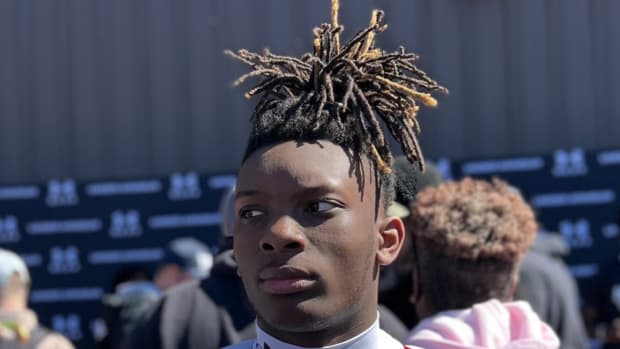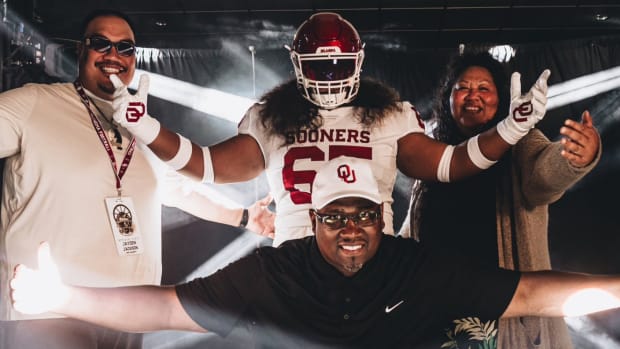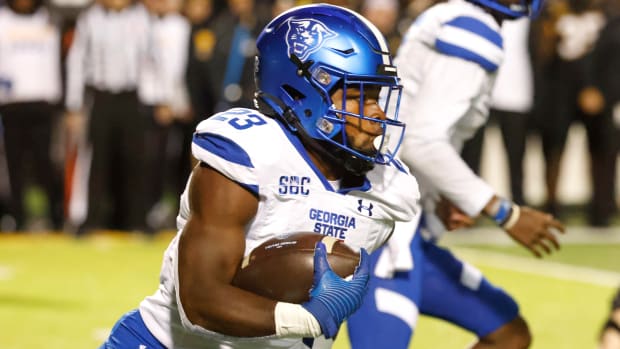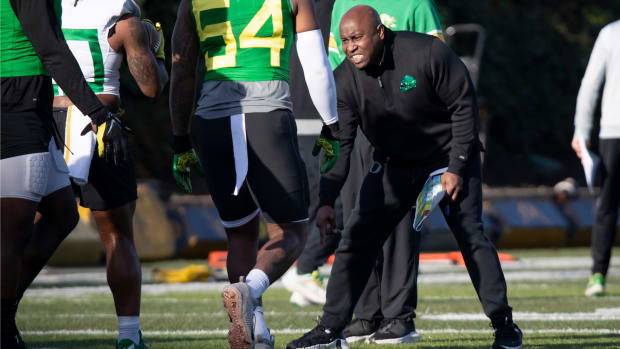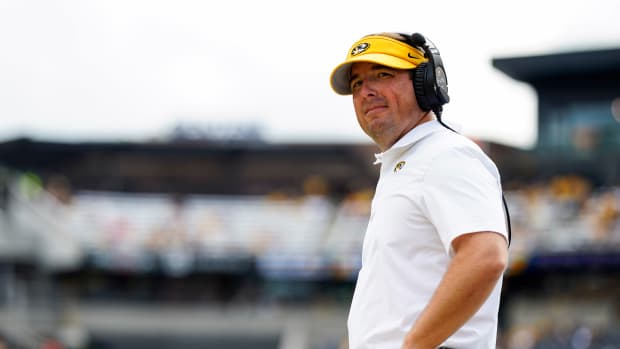Mike Locksley Leads Maryland Through Spring of Change With Jordan McNair Memories in Tow
COLLEGE PARK, Md. — The white jersey hangs over the aluminum bench, not slung like a dirty shirt over a dining room chair but delicately placed in a way that its name and number—McNAIR 79—are clearly visible to those attending the Maryland spring game. Carolina Panthers linebacker Jermaine Carter, one of two Maryland players selected in the 2018 NFL draft, points across Capital One Field at Maryland Stadium, through hustling football players and coaches, to that portable memorial. “Nobody is forgetting about him,” says Carter.
You have reached your limit of 4 premium articles
Register your email to get 1 more
The Terps are inching toward what they hope is a bright future while remembering what they acknowledge is a dark recent past. The new year has brought a new head coach, a new staff of assistants, a new head trainer and a new strength coach. There is a new offense, too: a no-huddle, hurry-up, pass-leaning spread that on this day is moving the ball with ease against the defense. Even the date on which head coach Michael Locksley scheduled the school’s spring game has meaning: April 27 was Maryland Day on campus, the university’s largest annual celebration.
The jersey belongs to lineman Jordan McNair, whose death last June after collapsing at a workout shone a light on a teamwide culture of abuse and fear-mongering that eventually led to the firing of head coach D.J. Durkin. Maryland is incorporating all of these new pieces while retaining that subtle reminder of last year draped over that bench, a flashlight pointing down a path to the future. “We’re always going to move forward, but the past is a part of you,” says Maryland athletic director Damon Evans. “You learn from the past and things that transpired then.”
Maryland’s new era begins with its new head coach. Locksley is a Maryland Man in the same way there are Michigan Men. Decades ago, he and his friends took the Metro north from their home in southwest Washington D.C. about a half-hour to New Carrollton before they boarded a bus to Maryland’s campus. He became a fan here, watching quarterbacks Boomer Esiason, Frank Reich and Stan Gelbaugh lead the Terrapins to three consecutive ACC championships. He became an ace recruiter here, serving under Ron Vanderlinden and Ralph Friedgen. He became a hot-shot coordinator here, calling plays for head coach Randy Edsall. And now he’s head coach here, with his first spring game complete and his emotions bubbling up just thinking about it all. “It is,” he says, “a dream come true.”
Locksley’s offense, despite its newness and missing its presumed 2019 starting quarterback, scored four touchdowns on his first-string defense, but the details of Maryland’s spring game are not the most important part of this day. This is a celebration of the program’s new-look leadership, as evidenced by the halftime entertainment: school officials presenting Locksley with the Broyles Award, a bronze trophy given to the nation's top assistant coach. Dressed in all black with the red “M” emblazoned on his chest, Locksley accepted an award he earned as Alabama’s offensive coordinator, the architect of one of college football’s most prolific units last year. An hour later, he sounded like his old boss, Nick Saban, telling a group of reporters in a postgame news conference that he’s already moved on to “the next phase”: a summer workout program that overlaps with what is sure to be an emotional anniversary. May 29 will mark one year since the day McNair collapsed from heat stroke during an offseason workout and was hospitalized. He died 15 days later.
The next phase for Locksley won’t be as tough as the first phase, when he took over a program shaken by tragedy. He followed the advice Saban gave to him to handle such a traumatic situation: develop meaningful relationships with your players. That wasn’t the toughest part. This was: “Answering questions about something that happened when I wasn’t here,” he says. “Obviously I know and understand what took place, but it’s hard for somebody to come in and comment on things that you really weren’t privy. I never read any of the reports. I didn’t look into ... I didn’t even watch film of our players last year. I wanted to come in with a clean slate and judge our guys based on how they performed and acted from the time I got hired and forward. That’s hard because every time I talked to someone about moving the program forward, there’s always the questions about last year.”
The questions may never completely stop, but the healing feels mostly complete. Locksley kept no one from the previous staff and hired a group connected to this place in the same way he is. His defensive line coach Delbert Cowsette played defensive tackle for the Terps, and cornerback coach Cory Robinson is from Baltimore. Running backs coach Elijah Brooks came from local high school powerhouse DeMatha Catholic, and special teams coordinator John Papuchis is from the D.C. suburbs. The school hired new athletic trainer Brian Simerville and new strength coach Ryan Davis, both of whom held a town hall–like meeting with players’ parents in March. Locksley and his staff’s deep connection to this community has helped close the wound. Still, a scar remains.
Turning the page all the way might never happen, says Jessica Jennings, the school’s senior associate athletic director in charge of communications. That’s O.K.—McNair’s memory is something to be preserved. His jersey, while also on that bench, is encased in the Terps’ locker room. The team plans to honor him toward the end of the 2020 season, on what would have been his Senior Day, when players will present to the McNair family a football that was signed by the entire team after last fall’s season-opening win over Texas. A new offensive line meeting room under construction will bear his name, and a scholarship has been created in his honor. Many of these things were inspired or voted on by players. “You see from them how much Jordan is on their mind,” Jennings says. As for the administration, the school has completed all but one of the 20 recommendations that former SEC trainer Rod Walters made in a 74-page report investigating practices that led to McNair’s death. Jennings says research is ongoing to check off No. 20: the housing of trainers.
Football here is beginning to feel like football again. On a sun-splashed, wind-swept, 70° spring day, more than 6,000 Terps fans are on hand to see Maryland play one of the latest spring games of the offseason. Locksley sacrificed some recruiting evaluation days by having his spring game so late, but it’s worth it, he says. He had more time in January, February and March to install the Alabama Way, and he brought back an old tradition by holding the spring game on Maryland Day. “I made a pretty deliberate decision with that,” he says. Locksley knows what this day means to the state and community. He’s got so much Maryland in him that it naturally pours out, as seen during his speeches on the school’s multi-stop spring tour around the state. Jennings need not make prepared remarks for the coach. There’s no script or rehearsed lines. “It comes from the heart,” she says. At one location, Evans ended his speech to a crowd of fans by speaking about current Maryland players who hail from that area. Locksley then one-upped him, wooing the room with tales of great Terps from yesteryear from the region. “He’s embedded in the community,” Evans says.
Locksley is bringing up the past to step into the future in more ways than one. Former players are pouring into the Terps’ practices like never before, and Locksley has created what was announced Saturday as “a new spring tradition” of distributing spring awards after each spring game, all of them named for Maryland greats. There’s the Shawne Merriman Big Hitter Award and the Vernon Davis “I like to practice” Award. Carter joined a group of former players in attendance Saturday, many of them there because of their relationship with Locksley. Carter remembers Locksley popping into his high school to recruit him, and he recalls the trying days after Edsall’s firing in 2015, when Locksley took over as interim coach. “You enjoyed coming to work for him,” Carter says. “Free, fun, loose.” Carter hears that Locksley has changed. Three years working under Saban will do that. “It’s not as free and loose anymore,” he says with a smile.
Locksley is bringing as much Alabama to his new team as he can. Maryland tight ends coach Mike Miller and graduate assistant Nick Cochran both followed him from Tuscaloosa, and players say they’ve watched Crimson Tide film to learn the new offense, run to near-perfection by Tua Tagovailoa last season. “Success leaves clues. I tried to pick up a lot of the clues I learned there,” Locksley says. “I’m not Nick Saban. I’m not going to try to be Nick Saban. But there are some processes and structural things that worked.”
He knows players win games, not coaches, and he’s turned to college football’s transfer portal to get them. The list includes Ohio State linebacker Keandre Jones and Virginia Tech receiver Sean Savoy, both already on campus. Josh Jackson, the former Hokies starting quarterback who many believe will start for the Terps, will join the team this summer. For all the new faces, there will still be that white jersey slung over that aluminum bench.
“He’s always with us,” says redshirt sophomore running back Anthony McFarland, who spent much of Saturday whizzing by McNair’s jersey, scoring a pair of touchdowns. “We’re never going to forget Jordan. We use it as motivation. I tell the guys, we need to have a good season for him. Would have been his senior year. One thing Jordan said he wanted to do was beat Ohio State over there.” The Terps meet the Buckeyes at Ohio Stadium on Nov. 9.
